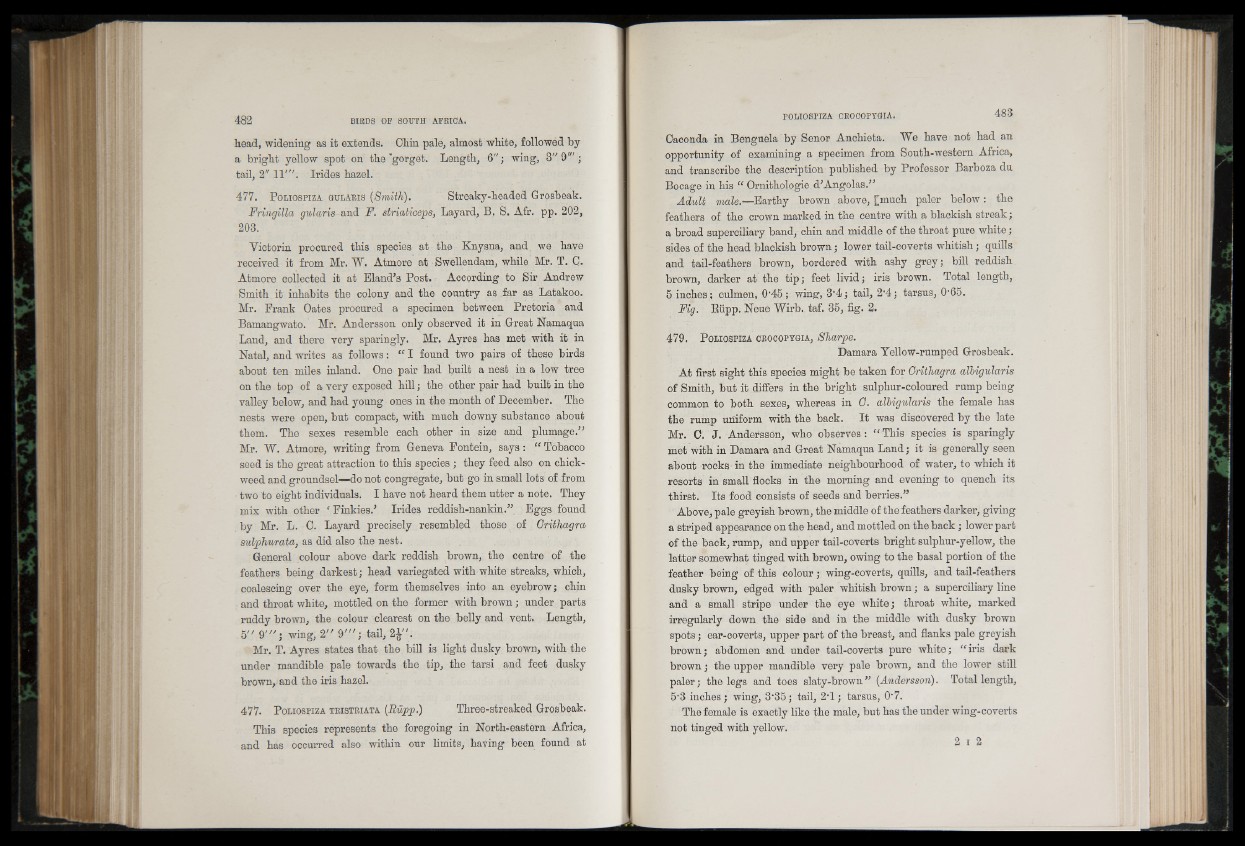
head, widening as it extends. Chin pale, almost white, followed by
a bright yellow spot on the "gorget. Length, 6"; wing, 3" 9"';
tail, 2" 11'". Irides hazel.
477. P o l io sp iza gularis (Smith). Streaky-headed Grosbeak.
Fringilla gularis and F. striaticeps, Layard, B. S. Afr. pp. 202,
203.
Victorin procured this species at the Knysna, and we have
received it from Mr. W. Atmore at Swellendam, while Mr. T. C.
Atmore collected it at Eland’s Post. According to Sir Andrew
Smith it inhabits the colony and the country as far as Latakoo.
Mr. Prank Oates procured a specimen between Pretoria and
Bamangwato. Mr. Andersson only observed it in Great Namaqua
Land, and there very sparingly. Mr. Ayres has met with it in
Natal, and writes as follows: “ I found two pairs of these birds
about ten miles inland. One pair had built a nest in a low tree
on the top of a very exposed hill; the other pair had built in the
valley below, and had young ones in the month of December. The
nests were open, but compact, with much downy substance about
them. The sexes resemble each other in size and plumage.”
Mr. W. Atmore, writing from Geneva Fontein, says: “ Tobacco
seed is the great attraction to this species ; they feed also on chick-
weed and groundsel—do not congregate, but go in small lots of from
two to eight individuals. I have not heard them utter a note. They
mi-ir with other f Finkies.’ Irides reddish-nankin.” Eggs found
by Mr. L. C. Layard precisely resembled those of Grithagra
sulphur at a, as did also the nest.
General colour above dark reddish brown, the centre of the
feathers being darkest; head variegated with white streaks, which,
coalescing over the eye, form themselves into an eyebrow; chin
and throat white, mottled on the former with brown; under parts
ruddy brown, the colour clearest on the belly and vent. Length,
5" 9 '" ; wing, 2" 9 " '; tail, .
Mr. T. Ayres states that the bill is light dusky brown, with the
under mandible pale towards the tip, the tarsi and feet dusky
brown, and the iris hazel.
477. P oliospiza tristr ia ta (Riipp.) Three-streaked Grosbeak.
This species represents the foregoing in North-eastern Africa,
and has occurred also within our limits, having been found at
Gaconda in Benguela by Senor Anchieta. We have not had an
opportunity of examining a specimen from South-western Africa,
and transcribe the description published by Professor Barboza du
Bocage in his “ Ornithologie d’Angolas.”
Adult male.—Earthy brown above, [much paler below: the
feathers of the crown marked in the centre with a blackish streak;
a broad superciliary band, chin and middle of the throat pure white;
sides of the head blackish brown; lower tail-coverts whitish; quills
and tail-feathers brown, bordered with ashy grey; bill reddish
brown, darker at the tip; feet livid; iris brown. Total length,
5 inches; culmen, 0‘45; wing, 3'4; tail, 2'4; tarsus, 0’65.
Fig. Rupp. Neue Wirb. taf. 35, fig. 2.
479. P oliospiza crocopygia, Sharpe.
Damara Yellow-rumped Grosbeak.
At first sight this species might be taken for Grithagra albigularis
of Smith, but it differs in the bright sulphur-coloured rump being
common to both sexes, whereas in 0. albigularis the female has
the rump uniform with the back. I t was discovered by the late
Mr. 0. J. Andersson, who observes: “ This species is sparingly
met with in Damara and Great Namaqua Land; it is generally seen
about rocks in the immediate neighbourhood of water, to which it
resorts in small flocks in the morning and evening to quench its
thirst. Its food consists of seeds and berries.”
Above, pale greyish brown, the middle of the feathers darker, giving
a striped appearance on the head, and mottled on the back; lower part
of the back, rump, and upper tail-coverts bright sulphur-yellow, the
latter somewhat tinged with brown, owing to the basal portion of the
feather being of this colour; wing-coverts, quills, and tail-feathers
dusky brown, edged with paler whitish brown; a superciliary line
and a small stripe under the eye white; throat white, marked
irregularly down the side and in the middle with dusky brown
spots; ear-coverts, upper part of the breast, and flanks pale greyish
brown; abdomen and under tail-coverts pure white; “ iris dark
brown; the upper mandible very pale brown, and the lower still
paler; the legs and toes slaty-brown ” (Andersson). Total length,
5'3 inches; wing, 3‘35; tail, 2T; tarsus, 0-7.
The female is exactly like the male, but has the under wing-coverts
not tinged with yellow.
2 i 2